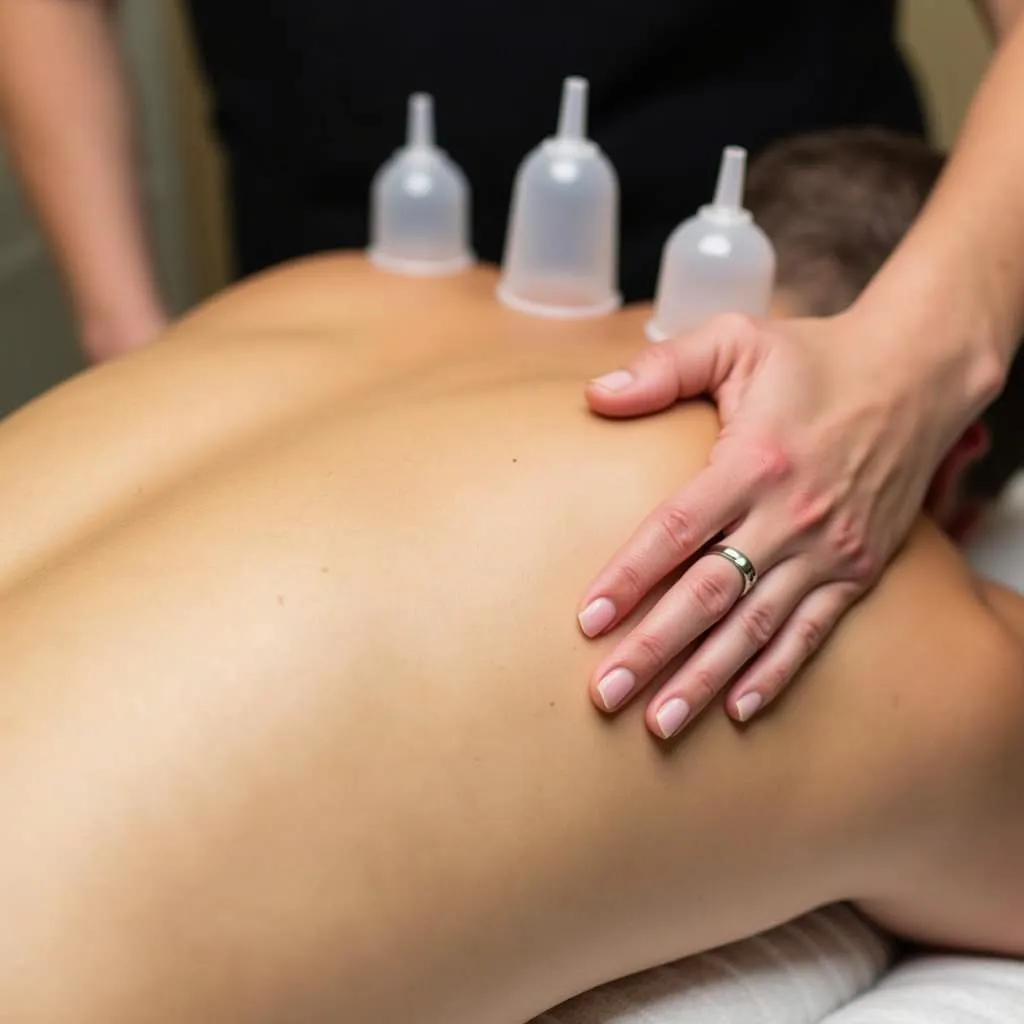Myofascial decompression cupping, often simply called “cupping,” is a therapeutic technique gaining popularity for its potential to relieve muscle tension, improve mobility, and promote relaxation. But what exactly is it, and how does it work? This comprehensive guide delves into the intricacies of myofascial decompression cupping, exploring its benefits, risks, and what to expect during a session.
Understanding Myofascial Decompression Cupping
Unlike traditional cupping methods that focus solely on creating suction, myofascial decompression cupping utilizes specialized cups and techniques to lift and stretch the skin and underlying connective tissues, known as fascia. This action helps to:
- Release muscle tension: The suction created by the cups draws blood flow to the area, helping to relax tight muscles and alleviate pain.
- Improve range of motion: By releasing restrictions in the fascia, cupping can improve flexibility and joint mobility.
- Reduce inflammation: Cupping is believed to promote lymphatic drainage, which can help reduce inflammation and swelling.
The Science Behind Cupping
While research on cupping is ongoing, several studies suggest that it may offer various physiological benefits, including:
- Increased blood flow: Cupping helps dilate blood vessels, improving circulation and oxygen delivery to muscles and tissues.
- Fascial release: The suction and lifting action of the cups helps to break down adhesions and restrictions in the fascia, restoring its normal gliding motion.
- Pain reduction: Cupping may stimulate the release of endorphins, the body’s natural pain relievers.
What to Expect During a Myofascial Decompression Cupping Session
A typical cupping session begins with a consultation to assess your health history and specific concerns. The practitioner will then apply cups to targeted areas of your body.
- Cup placement: Cups may be placed directly on areas of pain or discomfort, or along specific meridian lines in the body, depending on the practitioner’s approach.
- Suction and movement: Once the cups are applied, the practitioner will create a vacuum using a pump or by manually removing air. The cups may be left in place for several minutes or gently moved across the skin.
- Sensations: You may feel a tight, pulling sensation as the cups lift the skin and fascia. This sensation is generally well-tolerated and subsides as the tissues release.
Benefits of Myofascial Decompression Cupping
Myofascial decompression cupping is a versatile therapy that can address a wide range of musculoskeletal and wellness concerns, including:
- Back pain
- Neck pain
- Shoulder pain
- Headaches and migraines
- Sciatica
- Sports injuries
- Stress and anxiety
- Improved sleep quality
Risks and Considerations
Myofascial decompression cupping is generally safe when performed by a qualified practitioner. However, like any therapeutic modality, there are potential risks to be aware of:
- Skin discoloration: Cupping often leaves temporary circular marks on the skin, ranging in color from light pink to dark purple. These marks are not bruises and typically fade within a few days to a week.
- Skin irritation: Some individuals may experience mild skin irritation or itching after cupping.
- Contraindications: Cupping is not suitable for everyone, including pregnant women, people with certain skin conditions, or those taking blood thinners.
Conclusion
Myofascial decompression cupping is a promising therapeutic approach for addressing muscle tension, pain, and restricted mobility. Its ability to release fascial restrictions and promote relaxation makes it a valuable tool for enhancing overall well-being. If you’re considering trying cupping, consult with a qualified practitioner to determine if it’s right for you.
Frequently Asked Questions
-
Does cupping hurt? While you may feel a tight, pulling sensation during the treatment, it is generally not painful.
-
How long do the marks from cupping last? The circular marks left by cupping typically fade within a few days to a week.
-
How often should I get cupping done? The frequency of treatments varies depending on your individual needs and goals.
-
Is cupping safe for everyone? Cupping is not suitable for everyone, including pregnant women, people with certain skin conditions, or those taking blood thinners.
-
How do I find a qualified cupping practitioner? It’s important to seek out a licensed and experienced practitioner who has received proper training in myofascial decompression cupping.
Need More Information?
For more information about myofascial decompression cupping and other therapies, explore our website or contact us directly. Our team is here to answer your questions and help you achieve your wellness goals.
Contact us:
Phone Number: 0372999996
Email: [email protected]
Address: 236 Cầu Giấy, Hà Nội.
We have a 24/7 customer service team.

